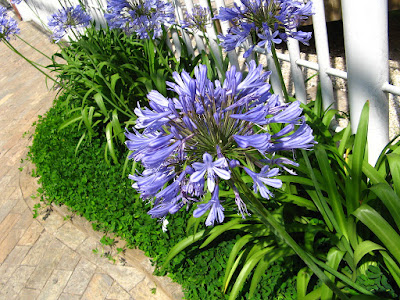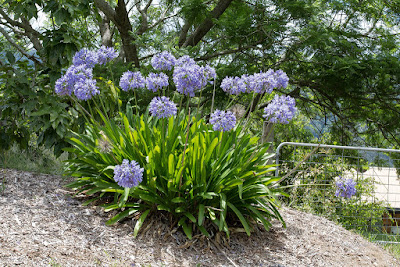Agapanthus is native to South Africa, Lesotho, Swaziland, Mozambique. In its native areas, this plant is considered to be both a magical and a medicinal plant, used to treat heart disease, paralysis, coughs, colds, and other ailments, and the leaves are used as bandages.
Agapanthus also called as Lily of the Nile, African lily, is a genus of the Amaryllidaceae family. This genus was described by Charles Louis L'Héritier de Brutelle in 1788.
IDENTIFY AGAPANTHUS PLANT
Agapanthus is native to South Africa, Lesotho, Swaziland, Mozambique. In its native areas, this plant is considered to be both a magical and a medicinal plant, used to treat heart disease, paralysis, coughs, colds, and other ailments, and the leaves are used as bandages (the plant does contain chemicals with anti-inflammatory and other properties). However, the plant’s sap can cause minor irritation or dermatitis in susceptible individuals, and will cause severe pain in the mouth if ingested.
Lily of the Nile is a tender herbaceous perennials grows in upright clumps from fleshy rhizomes that produce short, tuberous roots. Tufts of leaves are produced on short stems. The dark, glossy green leaves are attractive even when the plant isn’t flowering (some species have bluish leaves or are lighter green in color). Most of the common types are evergreen, but there are some that are deciduous. The evergreen ones shed a few of the older, outer leaves every year and grow new leaves from the growing shoot.
African lily bloom primarily in summer, although in frost-free climates they will bloom over a longer season from the sturdy, erect stems held well above the foliage. Each single terminal inflorescence consists of numerous tubular to bell-shaped flowers, each with 6 parts. There are 20 to 100 flowers in each rounded umbel, depending on variety and species. The individual flowers look like a miniature lily flower, often with darker stripes down the middle of each tepal (3 petals and 3 sepals that all look the same). Flower color ranges from deep violet-blue to pale shades of blue, as well as pure white. The flowers also make good cut flowers, and the dried seed heads can be used in arrangements.
There are two evergreen species (Agapanthus africanus and Agapanthus praecox) and four deciduous species (Agapanthus campanulatus, Agapanthus caulescens, Agapanthus coddii and Agapanthus inapertus). There are numerous hybrid cultivars with a range of characteristics and sizes: Albus (white-flowered), Baby Blue (bright blue flowers), Back in Black (dark blue flowers on dark stems), Blue Triumphator (deciduous types), Bressingham Blue (dark violet blue flowers), Bressingham White (white flowers), Elaine (upright and vigorous with deep purple-blue flowers), Ellamae (bright violet-blue drooping flowers), Getty White (large clusters of white flowers), Headbourne Hybrids (deciduous with flowers in various shades of blue), Lilliput dwarf with dark blue flowers), Monmid (deep, violet-blue flowers), Mooreanus (pale blue flowers), Peter Pan (vigorous dwarf with large clusters of mid-blue flowers), Queen Anne (bright blue flowers), Rancho White (white tubular flowers), Snow Cloud (rounded umbels of small, pure white flowers), Summer Gold (yellow variegated foliage and powder blue flowers), Storm Cloud or Purple Cloud (intense purple-blue flowers), Streamline (open flowerheads of mid-blue on dwarf plants), Tinkerbell (variegated leaves and pale blue flowers).
AGAPANTHUS PLANT CARE AND CULTURE
Cultural information should only be used as a guide, and should be to be adapted to suit you. Your physical location; where you grow your plants, how much time you have to devote to their care, and many other factors, will need to be taken into account. Only then can you decide on the cultural methods that best suit you and your plants.
Light:
Agapanthus can be grow as a houseplant in bright light. The plant requires good lighting in the summer, with a lack of light, the flower stalks are extended, and they need support. They grows best at a window with a south, southeast, or southwest orientation. This plant blooms best when grown in full sun.
Temperature:
Lily of the Nile need the average temperatures. In summer, the optimal temperature is at around 25 ℃. In winter a low temperature of 10-12 ℃ is desirable.
Substrate and growing media:
Plant African lily just deep enough to cover the roots, spacing them about 8” apart. A single plant will fill a 12” pot, or use more in larger pots. Use well-drained potting mix, as they do not tolerate waterlogged soil. For good growth and abundant flowering Agapanthus requires a nutrient mixture of clay-sod, humus, leaf soil and sand (2: 2: 1: 1).
Young and medium-sized specimens are transplanted every spring, adult plants every 3-4 years. Agapanthus does not like frequent transplants, blooms best in a close pot. When transplanting, be careful, as the rhizomes of Agapanthus are carelessly broken when carelessly applied and the plant may not tolerate the transplant.
Watering:
Keep the plant well watered when growing, but allow it to dry out in winter. Making sure that the substrate does not dry out completely. If watering is excessive, water may stagnate, which leads to acidification of the soil.
Fertilizer:
During the growing season, the plant can be fertilize every 10 days (April to October). In the winter, during the rest period the plant is not fed.
Rest period:
Keep African lily outdoors as long as possible in the fall because they need a cold period in order to flower well the next season. However, do not subject your plants to heavy frost (28ºF). In winter Agapanthus should be place indoors in a cool location with bright light such as in a mudroom, by a window in a garage that does not freeze, or in a room that is kept cool (45ºF - 55º F). Keep your Agapanthus on the dry side, watering perhaps once a month. If plants are kept too warm during the winter they will force into bloom before summer.
Although most Agapanthus will not be dormant during the winter, neither will they be in active growth. Reduce watering and do not fertilize during this time. In the spring, after danger of frost has passed, place your Agapanthus outdoors, gradually moving them from part sun to full sun, and begin watering and fertilizing regularly.
Propagation:
Lily of the Nile can be propagated from seed or division. Seed should be sown in spring; germination usually takes 1-4 months. It will take 3-5 years to flower from seed. Root bound potted plants can be divided every 4-5 years. Division is best done after flowering, but it can be done any time. Use a very sharp knife to cut the clump into sections, each with roots attached, and pot the sections up. Divisions may not flower until the following year.
BUY AGAPANTHUS PLANT AND RELATED PRODUCTS
SOME SPECIES AND VARIETIES OF AGAPANTHUS WITH CARE TIPS AND CULTURE:
- Agapanthus africanus - African lily - African Tulip
- Agapanthus campanulatus - African bluebell - African Blue lily - Bell Agapanthus
- Agapanthus caulescens - Stalked African lily
- Agapanthus coddii - Waterberg agapanthus - Codd's agapanthus
- Agapanthus Galaxy Blue - Galaxy Blue Lily of the Nile
- Agapanthus inapertus - Drakensberg Agapanthus - Drooping Agapanthus
- Agapanthus Northern Star - Northern Star Lily of the Nile
- Agapanthus praecox - Common agapanthus - Blue lily - African lily - Lily of the Nile
- Agapanthus walshii - Agapanthus africanus subsp. walshii















COMMENTS